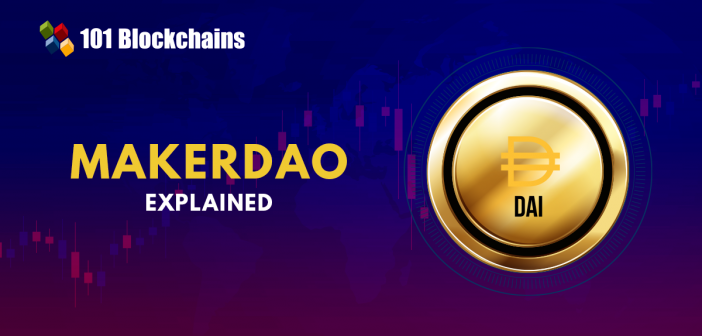Learn how blockchain truly works, master key definitions, and uncover what makes smart contracts so "smart." Dive into the fundamentals, gain valuable insights, and start your blockchain journey today!

- Guides
James Howell
- on March 04, 2022
What is MakerDAO and How it Works
The foremost highlight in the domain of cryptocurrencies and crypto-assets is volatility. Continuous fluctuations in the price of cryptocurrencies and crypto-assets on a massive scale often lead to many concerns regarding mainstream crypto adoption. The massive price fluctuations of cryptocurrencies and crypto assets present formidable setbacks for borrowing such assets. As a result, solutions such as MakerDAO have been making a formidable impact on the crypto sphere.
It has evolved as a crucial answer for doubts about the repayable amount on crypto loans. So, it is a crypto lending platform? You would need more than just a “crypto platform” for explaining how MakerDAO works and serves different functionalities. The following discussion will offer you a detailed overview of the new decentralized platform tailored for crypto-based lending and borrowing functionalities.
Want to become a Cryptocurrency expert? Enroll Now in Cryptocurrency Fundamentals Course
What is MakerDAO?
The obvious entry at the beginning of a discussion on MakerDAO would refer to its definition. It is basically a peer-to-peer or decentralized organization focused on developing technology to facilitate savings, borrowing, and lending functionalities along with a stable cryptocurrency on the Ethereum blockchain network. The MakerDAO crypto protocol allows any individual with ETH (Ether) and a Metamask wallet to participate in lending and borrowing.
Interestingly, you can lend yourself money in the form of the stable cryptocurrency, DAI, on the platform. Users have to lock a certain amount of ETH in the smart contracts of MakerDAO or MKR protocol for creating a specific amount of DAI. Basically, you will have to pay ETH as collateral for DAI loans.
If you want to unlock your ETH from the platform, you need to pay back the loan alongside other fees incurred in the process. The promising functionalities of the peer-to-peer lending, borrowing, and savings protocol fuel further interest in it. Doesn’t it remind you of DeFi solutions?
Excited to develop fluent knowledge of the DAO ecosystem? Enroll now in DAO Fundamentals Course!
Background of MakerDAO
The next significant highlight in an account of MakerDAO explained comprehensively would be the background of the protocol. You need to understand what exactly drove the origins of such a unique protocol. Interestingly, the decentralized lending platform is one of the first projects in the DeFi space. The platform’s founder, Rune Christensen, is currently the CEO of the platform. It also successfully garnered an investment of $15 million from venture capital firm Andreessen Horowitz in 2018. Where did all these start from?
The basic premise for introducing a platform like MakerDAO revolves around the approaches followed for lending and borrowing on the blockchain. One would reasonably wonder how borrowing works on the blockchain without any credit checks in a trustless environment. In such cases, the obvious answer often points towards liquidity, which implies the possibility of converting an asset into capital.
The MakerDAO crypto protocol introduced the benefit of liquidity in crypto lending and borrowing. For instance, when the collateral for a specific loan, i.e., ETH, has dropped in value by a considerable margin below the amount of the loan in DAI, the loan goes through liquidation. Therefore, the platform can sell off ETH collateral for paying loans borrowed in DAI alongside the fees and penalties. You can notice how liquidity and the threat of liquidation ensure stability in lending and borrowing on blockchain.
Build your identity as a certified blockchain expert with 101 Blockchains’ Blockchain Certifications designed to provide enhanced career prospects.
Working of MakerDAO
The popularity of the MakerDAO protocol has doubled up considerably in recent times. As a matter of fact, it is one of the most commonly used and longest-running projects in the DeFi ecosystem. The protocol has almost 2.3 million ETH locked in it, which accounts for a significant share of total ETH supply. Therefore, anyone would wonder about how MakerDAO works and its components to understand why it is special.
As of now, you must have understood how the MakerDAO platform is basically a crypto lending and borrowing solution. The protocol includes a combination of smart contracts deployed on the Ethereum blockchain. The Maker protocol helps in facilitating the crypto loans against collateral placed by borrowers.
However, the collateral in the case of Maker protocol differs from that used in traditional loans, i.e., cash. On the contrary, users have to borrow loans against multiple crypto pairs supported by the protocol. For example, you can borrow DAI in return for ETH in an ETH/DAI crypto trading pair.
Borrowers basically deposit the collateral in smart contracts. As a matter of fact, Ethereum smart contracts dictate all the terms for facilitating and managing crypto loans on the MakerDAO crypto lending protocol. On top of it, The Maker Foundation controls the Maker protocol for facilitating complete transfer of ownership of crypto assets. Most important of all, the Maker Foundation helps in realizing the functionalities of the Maker protocol as a completely Decentralized Autonomous Organization or DAO.
Curious about the Ethereum Technology ? Enroll now in Ethereum Technology Course
Tokens of MakerDAO
Speaking of a Decentralized Autonomous Organization or DAO in identifying “how does MakerDAO work,” governance would emerge as a prominent highlight. What is the assurance of decentralization when the Maker Foundation exerts control over the Maker protocol? This is where you need to take note of the tokens on the MakerDAO platform, i.e., DAI and MKR. Both the tokens are core components of the protocol and serve essential functionalities.
-
DAI
First of all, you need to note that the DAI token is a stable cryptocurrency pegged against the US dollar. The operations of DAI depend considerably on supply and demand trends. It serves as the medium for facilitating loans against the collateral placed by borrowers on the platform.
-
MKR
The MKR token, on the other hand, is an essential requirement in the MakerDAO crypto protocol for providing liquidity. With the help of MKR token, the platform can easily resolve concerns arising due to accumulation of bad debts. The MKR token serves many key functionalities on the protocol, especially governance.
MKR tokens offer governance rights that can help users in regulating the development of the platform. In addition, MKR token holders are generally the last resort for borrowers. For example, if collateral does not cover the amount of DAI loans in circulation, the protocol mints MKR tokens and sells them.
Want to know about top 10 DAO tokens? Read: Top 10 Decentralized Autonomous Organization (DAO) Tokens
Collateral Assets
The understanding of “how does MakerDAO work” also brings the topic of relevant collateral assets into question. DAI generated on the platform largely depends on collateral assets in the Maker Vaults of the protocol. In addition, collateral assets also back the DAI and ensure its stability. In other words, a collateral asset is any type of digital asset which MKR token holders have deemed eligible for the protocol.
The Maker protocol would accept any type of Ethereum-based asset with the approval of MKR holders. Furthermore, MKR token holders will have to provide approval for specifically related risk parameters in each approved collateral.
Maker Vaults
Another significant highlight in the working of MakerDAO explained clearly would refer to Maker Vaults. You must have heard a lot about depositing collateral in smart contracts on the Maker protocol for obtaining crypto loans. The Maker Vaults in the protocol are basically the smart contracts that help in leveraging all the supported collateral assets for generating DAI in the protocol.
Users have the facility for accessing Maker protocol to create Maker Vaults. You can make the most of various user interfaces or network access portals and different interfaces developed by the community. The process for creating Maker Vaults is quite simple, albeit with trivial concerns due to obligations for repaying DAI alongside stability fees for unlocking the collateral locked in the vaults.
The next crucial feature of Maker Vaults in the MakerDAO platform is that they are non-custodial by design. As a result, users can interact with the Maker Vaults and the protocol itself directly. All users have comprehensive and independent control on the collateral they have locked in the protocol unless the value of the collateral falls below a stipulated minimum level.
External Agents Working in MakerDAO
The smart contract infrastructure in the Maker protocol and Maker vaults definitely shows how MakerDAO works as a decentralized crypto lending platform. On the other hand, there is more to the working of Maker protocol than just the smart contracts. The Maker protocol depends on some external actors for maintaining their operations. Here is an outline of the external actors supporting the MakerDAO ecosystem and the value they bring to the platform.
-
Keepers
Keeper in the Maker protocol is actually an independent agent receiving incentives through arbitrage opportunities for offering liquidity.
-
Price Oracles
The MakerDAO crypto protocol leverages a decentralized oracle infrastructure to obtain real-time information regarding the market prices of collateral assets in the Maker Vaults. Price Oracles play a crucial role in determining the opportune moments for triggering liquidation.
-
Emergency Oracles
The Emergency Oracles in Maker protocol serve as the last resort for defense against attacks on governance of the platform or other oracles.
-
DAO Teams
Maker protocol also contracts DAO teams, including individuals and service providers, to ensure governance functionalities. Interestingly, members in DAO teams are independent market players, thereby introducing credibility in the governance of the protocol.
Want to know about blockchain oracles, smart contracts and the oracle problem? Read: Understanding Oracle, smart contracts and the oracle problem in detail here!
Use Cases of MakerDAO
The final highlight in any discussion on MakerDAO and its functionalities would obviously bring its use cases to the equation. One of the clearly evident use cases of Maker protocol is evident in crypto lending functionalities. The Maker protocol and its stablecoin DAI offer a productive base layer infrastructure for driving the development of other DeFi protocols.
Global organizations such as UNICEF use DAI stablecoin to obtain funding for blockchain-based open-source initiatives in social projects. Other notable practical DeFi applications powered by the Maker ecosystem refer to Uniswap and Outlet.
Furthermore, the applications of MakerDAO explained in the gaming industry can help in the creation of tokenized in-game assets. The platform also focuses on introducing DAI in the art world by providing incentives to artists for trading their artwork as NFTs.
Start learning Blockchain with the World’s first Blockchain Career Paths with quality resources tailored by industry experts Now!
Conclusion
The basic premise of the foundations of MakerDAO crypto lending platform serves favorable prospects for its long-term growth. The Maker protocol resolves one of the long-standing issues for borrowing and lending on blockchain networks by introducing liquidity. At the same time, the assurance of trust through smart contracts also serves as a vital advantage for the Maker protocol.
With the help of two distinct tokens, i.e., DAI and MKR, the Maker protocol provides control in the hands of users. Furthermore, the emphasis on DAO and external agents is also a formidable aspect for strengthening the prospects of Maker protocol. Start learning more about the protocol and how it works practically right now.
*Disclaimer: The article should not be taken as, and is not intended to provide any investment advice. Claims made in this article do not constitute investment advice and should not be taken as such. 101 Blockchains shall not be responsible for any loss sustained by any person who relies on this article. Do your own research!





